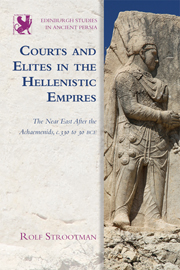Book contents
- Frontmatter
- Contents
- List of Illustrations
- Acknowledgements
- Abbreviations
- The Hellenistic Dynasties
- Series Editor's Preface
- Map
- Introduction: Court and Empire in the Hellenistic Near East
- PART I SETTING THE SCENE
- PART II THE COURT AS A SOCIO-POLITICAL SYSTEM
- PART III CEREMONIAL AND RITUAL
- Conclusion
- Bibliography
- Index
Introduction: Court and Empire in the Hellenistic Near East
Published online by Cambridge University Press: 05 September 2014
- Frontmatter
- Contents
- List of Illustrations
- Acknowledgements
- Abbreviations
- The Hellenistic Dynasties
- Series Editor's Preface
- Map
- Introduction: Court and Empire in the Hellenistic Near East
- PART I SETTING THE SCENE
- PART II THE COURT AS A SOCIO-POLITICAL SYSTEM
- PART III CEREMONIAL AND RITUAL
- Conclusion
- Bibliography
- Index
Summary
After the fall of the Achaemenids in 330 BCE the eastern Mediterranean, Iran and Central Asia were ruled by Macedonian empires, successor states of Alexander the Great's empire. Ending two centuries of relative unity, the former Achaemenid world now became divided between three competing imperial dynasties: the Seleukids, Ptolemies and Antigonids. How far these dynasties (and especially the Seleukids, who controlled territories stretching from the Aegean to present-day Afghanistan) willingly or unwillingly ‘Hellenised’ the Middle East is difficult to ascertain due to a relative dearth of archaeological evidence from the third and second centuries BCE. What we do know from both literary sources and the archaeological record is that in the course of time, the Seleukids increasingly cooperated and intermarried with noble families with an Iranian and mixed Macedonian-Iranian identity, which resulted in the creation of various small kingdoms and the re-emergence of Iranian culture, particularly in Anatolia, Armenia and Iran – often in the form of a deliberate invention of tradition that may be called ‘Persianism’. Still, the Macedonian and Greek element played a pivotal role too, and probably more so than recent scholarship has suggested. Greeks and Macedonians after all did constitute the central elites in the Hellenistic empires. The post-Achaemenid centuries were a time of vigorous cultural encounters in the Middle East and Central Asia.
- Type
- Chapter
- Information
- Courts and Elites in the Hellenistic EmpiresThe Near East After the Achaemenids, c. 330 to 30 BCE, pp. 1 - 28Publisher: Edinburgh University PressPrint publication year: 2014



